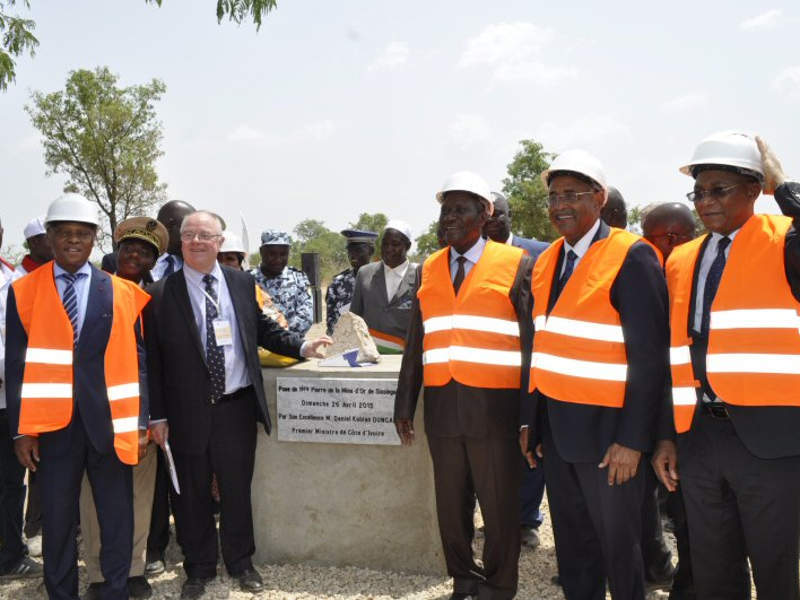Sissingue gold project is situated in northern Côte d’Ivoire, approximately 620km north-west of Abidjan.
Developed by Perseus Mining with an investment of $107m, the gold project commenced production in January 2018.
The West African gold mine is expected to produce 80,000 ounces (oz) of gold per annum in the first 3.25 years of operation and total 358,000oz of gold over the five-year mine life.
The Sissingue gold project is 86% owned by Perseus’ wholly owned subsidiary Perseus Mining Côte d’Ivoire (PMCI), the State of Cote d’Ivoire (10%) and the local joint-venture partner Société Minière de Côte d’Ivoire (SOMICI, 4%).
Sissingue gold project background
The Sissingue gold project, previously known as the Tengrela gold project, was acquired by Perseus Mining in March 2004.
After the expiry of Tengrela East Permit, Perseus’s Ivorian subsidiary Occidental Gold (OGIC) was granted the PE 39 exploitation permit in August 2012, which was subsequently transferred to Perseus’s new Ivorian subsidiary PMCI in July 2013.
The environment permit for the Sissingue gold project was issued in February 2012.
Sissingue geology and mineralisation
The 4km-long and 1.5km-wide Sissingue gold-in-soil deposit is situated in the northern portion of volcano-sedimentary Syama-Boundiali Greenstone Belt.
The gold mineralisation in the Sissingue deposit is associated with veined, altered and sulphidised felsic intrusive bodies. The mineralisation at Sissingue is identified mainly in three different forms that include disseminated mineralisation in the sericite, coarse gold-bearing mineralisation in milky quartz veins and low-grade dispersed mineralisation within dark coarse-grained sandstone.
Sissingue gold mine reserves
The mine was estimated to hold proven and probable mineral reserves of 5.9 million tonnes (Mt) grading 2.1 grams per tonne (g/t) gold, containing 400,000oz of gold, as of March 2017.
Mining and ore processing at Sissingue
The mining method employed at Sissingue is selective conventional open pit mining with the use of hydraulic excavators and trucks. Drilling and blasting is conducted on 5m benches in ore and on 10m-high benches in waste. Digging is conducted on flitches of 2.5m height.
Rear dump trucks are used for hauling to the run-of-mine (ROM) pad, surface ore stockpiles and waste disposal dump. Front-end loaders are used for re-handling the stockpile.
Mining at Sissingue is planned to be carried out in three phases. In the initial cutback phase, high-grade zones bordering the surface are being accessed after which the mine will be expanded from north to south on striking the ore zone. The depth of the pit will be increased to match the strip ratio in the final phase.
The Sissingue processing plant located near the mine has a throughput capacity of 1.8 million tonnes per annum (Mtpa) on oxide ore and 1.0Mtpa capacity on fresh ore. The plant houses crushing, grinding, gravity recovery and cyanide leaching facilities for gold extraction. Sissingue ore is reduced to grind size of 106μm before final processing.
Infrastructure facilities at Sissingue
Sissingue gold project is accessed from Tengrela via a 23km-long and 6m-wide all-season gravel road, which underwent an upgrade as part of the project.
Power supply for the mining and processing operation is met through four dedicated 1.6MW diesel generators.
The source of water for the mine is mainly groundwater extracted from dedicated boreholes supplemented with water pumped from the nearby Bagoe River. Water is stored in a storage tank situated beside the potable water treatment facility at the processing plant.
The mine site also features an airstrip and a camp to accommodate 150 non-local employees.
Contractors involved with the West-African gold project
Lycopodium, an international engineering company based in Australia, was awarded the $38.4m engineering procurement and construction (EPC) contract for the Sissingue gold project in August 2016.
Lycopodium had also conducted the definitive feasibility study (DFS) and the front-end engineering and design (FEED) study of the gold project.
Canada-based company Geotech Airborne, in a joint venture with Resolute Mining and Etruscan Resources, conducted the airborne VTEM/ Magnetics survey for the gold mine.
Sagax Afrique, an engineering extractive company based in Burkina Faso, conducted induced polarisation (IP) survey for the project.
Australia-based Coffey Mining conducted the structural study of the Sissingue ore body. RungePincockMinaro (RPM) in liaison with Perseus crew conducted the detailed mining study.
Contract drilling companies Foramin and Boart Longyear were engaged for reverse circulation (RC) drilling at Sissingue.
Ghana-based contract surveyor SEMS Exploration Services surveyed all reverse circulation (RC) and diamond holes using differential global positioning system (GPS).
Australian mining consulting company Snowden prepared the mineral resource estimate for Sissingue gold mine.




